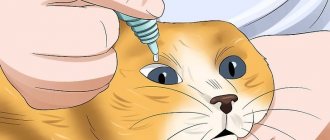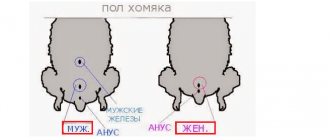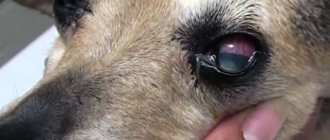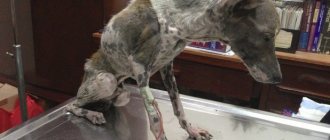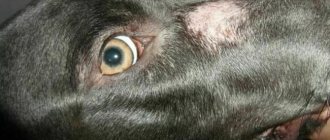The most common pathologies in hamsters
There are practically common symptoms of some diseases by which you can determine that your hamster is unwell:
- hamsters love to eat and if they suddenly refuse food, be wary;
- increased thirst becomes an alarming signal;
- You should be concerned if increased salivation begins ;
- Wet fur on the back or traces of feces are also alarming;
- lack of stool is also a sign of malaise;
- purulent discharge from the eyes and profuse lacrimation;
- nasal discharge, rapid breathing with wheezing;
- the fur of a sick hamster becomes dull and begins to fall out;
- Unnatural swelling is visible on the body;
- the animal becomes inactive and lies down almost all the time;
- convulsions may begin.
If any of these symptoms are present, immediate action should be taken. And if there are several such manifestations, you need to act decisively. And, if possible, determine the nature of the disease that has affected your pet.
Have you observed any of these symptoms in your pet?
Oral and dental diseases
Since we are talking about rodents, whose teeth often withstand heavy loads, such pathologies are often encountered in them.
Pathologies of the cheek pouches
There may be quite a lot of them:
- the bag sometimes becomes clogged , the reason for this is not only small grains, but pieces of paper or cotton wool, especially when they dry out in the bag - the help of a veterinarian is necessary to clean them, otherwise inflammation will begin;
- it happens that a hamster, trying to free a clogged pouch, literally turns it out, then the help of a veterinarian is urgently needed - the pouch is returned to its place and lightly hemmed; stitches are removed after 2 weeks;
- if the sac becomes severely inflamed, it is removed surgically;
- Sometimes the sacs are affected by a tumor, this is called neoplasia - tumors of this kind are also removed.
At home, a hamster can exist without pouches, because it does not need to store food. But in nature, without these organs, a hamster usually dies from starvation in the winter.
Dental problems
The main dental problem in these animals is uneven grinding of the incisors. In this case, the overgrown incisor may grow into the pouch or injure the palate. You should contact your veterinarian to have your incisors sharpened.
It happens that a hamster often chews the metal bars of the cage and breaks its incisors. There is no need to worry too much about this, they will grow back naturally.
Eye diseases
Cataract
Cataracts are even more common in rodents than, for example, in dogs or cats. Unfortunately, it is very difficult to notice this disease at an early stage due to the small size of the eyes of these animals.
ATTENTION! Once cataracts develop, they may not bother the rodent at all. But when a mature cataract disintegrates, the inflammation inevitably spreads to the eye, and the animal dies.
Removal of cataracts in small rodents is technically possible using elements of microsurgery. But even abroad they are practically not performed due to the high cost. Veterinary care in such cases consists of complete removal of the eye.
Conjunctivitis
Purulent discharge from the eyes is much more dangerous for a hamster than for humans. The animal can not only lose its sight, but also die if left untreated.
If conjunctivitis is detected, it is advisable to seek help from a veterinarian. But if this is not possible, use eye drops, just do not overdo it with the dosage.
In most cases, this disease is infectious in nature , but conjunctivitis and allergic conjunctivitis occurs in hamsters when the animal is overfed with fruits, mainly exotic ones. To exclude the presence of an allergen, the pet should be put on a strict diet during treatment.
Gastrointestinal diseases
Salmonellosis
This is an acute infectious disease that usually ends in the death of the animal. Young animals under the age of 24 weeks are usually susceptible to it . The disease has 3 forms:
- acute - the disease develops very quickly: the animal’s temperature rises sharply and diarrhea with blood appears; within a week, hamsters with such symptoms usually die;
- subacute - death may occur within 2 weeks;
- chronic - the incubation period lasts up to 1 month.
The cause of this disease is poor-quality feed, overcrowding of individuals, and the presence of poultry nearby.
Stress
If a hamster, not accustomed to human hands, is brought home and immediately picked up in the palm of your hand, the animal can suffer real stress and may develop an upset stomach.
This can also happen with unusual sharp sounds or flashes of light. The appearance of another pet near the cage , for example, a dog or cat, can cause stress.
REFERENCE! Once the stressful situation is localized, the pathology usually goes away.
Improper feeding
Disruption of the gastrointestinal tract in a hamster can be caused by improper feeding. As already noted, exotic fruits and citrus fruits can upset an animal’s stomach. Diarrhea can be caused by an unbalanced diet. Let's say rodents need protein in certain quantities. But frequent feeding of protein foods, fats, and herbs is also harmful.
It is curious that quite often an upset stomach in these pets can cause disruption of daytime sleep if the animals are not given time to fully rest.
Colibacillosis (escherichiosis)
This disease is infectious. Caused by E. coli. It is not difficult to recognize - the animal begins to have severe diarrhea with very loose stools.
The hamster quickly loses weight, eats almost nothing, and moves little. It is necessary to contact a veterinarian; usually treatment is prescribed with antibiotics, the dose is determined by the doctor.
Poisoning
The causes of animal poisoning may be the following:
- there may be seeds of a poisonous plant in the food;
- green potatoes can also be a reason for such ailment;
- moldy food;
- some indoor plants can be poisonous to a hamster, you need to remember this when letting him out for walks;
- if the food was stored in copper or zinc containers.
Symptoms of poisoning look like this:
- the hamster drinks water often;
- becomes lethargic and apathetic;
- the animal often salivates profusely;
- vomiting or diarrhea begins;
- in a state close to critical, convulsions may begin, followed by paralysis.
The sooner the animal receives help, the better the treatment outcome will be. Usually, if there are signs of poisoning, the hamster’s stomach is washed with warm water and a weak solution of potassium permanganate. If zinc or copper poisoning occurs, the animal is given warm milk.
Wet tail
It can be caused by cystitis, an inflammation of the bladder. The animal experiences pain when urinating and drinks water greedily and often.
The reason for this condition is hypothermia and being in a draft. The pet should be placed in a warmer room. Treated with antibiotics.
Coccidiosis
The disease is caused by coccidia, protozoan parasites. These microorganisms can live in the animal's intestines without causing complications. However, they begin to multiply quickly if they are poorly fed or damp.
The disease causes diarrhea, bloating, and lethargy. Treatment is possible with antibiotics with changing conditions. If the pathology is not treated, the animal may die.
Pathologies of the limbs
Injuries
In natural conditions, a hamster lives on a plain, so its concept of height is not developed. He can fall from the table, from the sofa, or simply fall out of the cage. The consequence may be a broken limb.
In this case, you should contact your veterinarian and apply a fixing bandage. In severe cases, amputation of the limb may follow, but this is not fatal.
Abscesses
They can be the result not only of injuries, but also of bites from other hamsters. If the abscess develops severely, it should be opened by contacting a veterinarian.
After surgery, drainage is sometimes installed, and it becomes necessary to periodically wash the limb. So the animal should be observed by a doctor for several days.
Exchange disorders
Metabolic disorders may include the following.
Vitamin deficiency and mineral deficiency
If an animal's nutrition is inadequate, its fur begins to fade and fall out, the tips of its ears crack and may even begin to bleed.
It is not difficult to treat this condition; just buy food with vitamin supplements in the store. You can also use vitamins for people, for example, Complivit.
Obesity
This condition is not difficult to identify. Feel your pet's ribs. If they stick out a lot, this is a sign of exhaustion. If, on the contrary, they are not palpable, obesity is evident. Excess weight can cause heart disease, clogged blood vessels and generally shorten a rodent's lifespan. Immediate measures should be taken:
- reduce the amount of feed, especially nuts;
- add more greens and vegetables to your diet;
- purchase a running wheel if the cage does not have one.
Diseases of the skin, fur and claws
Hamsters are susceptible to diseases of the fur, skin and claws.
Mouse pox
The disease can develop in a chronic form with virtually no symptoms. Such hamsters usually develop immunity over time. In its acute form, mousepox is expressed in the appearance of small spots, ulcers, and bleeding areas under the fur on the body.
IMPORTANT! This disease does not pose a danger to humans; people do not become infected with it.
In the acute form of the disease, the animal usually dies within a few days; it cannot be treated by veterinarians.
Dermatitis
A hamster can become infected with scab. It is recognized by the appearance of characteristic scabs. First, they should be softened with oils and removed. Then the infected area must be treated with an alcohol solution or iodine.
Parasites
It's rare, but rodents can get fleas, lice or lice on their bodies. Their presence can be determined by examining the skin by slightly parting the animal's fur. The hamster often itches and becomes restless. It is easy to get rid of such uninvited guests with the help of special shampoos.
It is easy to get rid of worms using appropriate medications. Just don’t delay this. Helminths can quickly cause severe intoxication of the rodent's body and its subsequent death.
Dermatomycoses
They are rare in rodents and are usually transmitted to them from larger domestic animals such as dogs or cats. Ringworm usually appears as ringworm.
This pathology is transmitted to humans , so be careful. Ringworm is expressed in bald areas of the body that can bleed and fester. It is treated with special ointments and shampoos.
Alopecia
This is what is called baldness, hair loss. It can be caused in hamsters by the following reasons:
- allergies;
- poisoning;
- vitamin deficiency;
- fungus;
- the presence of skin mites;
- as already noted, the cause of alopecia can be lichen.
To determine the cause of baldness and its treatment, you should contact a veterinary clinic.
Respiratory diseases
Lymphocytic choriomeningitis
A very serious infectious disease. Its carriers are mice. The hamster's temperature quickly rises and breathing becomes noticeably difficult.
Unfortunately, this disease is incurable and ends in the death of the animal.
Trichomoniasis
The disease is caused by the parasite Trichomonas gallinae. It usually enters the rodent's body with food or water. The throat of a sick individual turns yellow and swells. Successfully treated in a veterinary clinic.
If you do not provide your hamster with timely help, he may die from lack of oxygen.
Respiratory infections
Diplococcal infection
The signs of this disease are easy to notice:
- the hamster becomes lethargic;
- sometimes he exhibits tremors;
- coughing and wheezing occur;
- the animal quickly loses weight.
Treatment is carried out by administering the appropriate serum. Without this, the animal dies a few days after infection.
Infectious pneumonia
It can not only be transmitted as an infection, but also occur as a result of hypothermia. The symptoms are as follows:
- mucous discharge;
- cough;
- hoarse breathing.
Pneumonia is often accompanied by conjunctivitis. The disease can be quickly treated by administering appropriate medications.
Diseases that cause symptoms of a nervous disorder
Diseases that cause symptoms of a nervous disorder include the following.
Rabies
It occurs in hamsters in case of contact with an infected fellow. Symptoms:
- excessive salivation;
- convulsive movement of paws.
Treatment is possible, but only if the first infected animal does not die within 2 weeks.
Encephalitis
It is transmitted by parasites, mainly ticks. Expressed in paralysis. It develops very quickly. Death almost always occurs.
False rabies
Also called Aujeszky's disease. Transmitted by a virus, it begins with severe itching. Then symptoms of paralysis appear.
She is being treated at the clinic, but needs timely treatment.
Injuries and tumors
Spinal cord tumors and spinal injuries are common in rodents. Symptoms are noticeable:
- progressive paresis followed by paralysis;
- spontaneous excretion of feces and urine;
- breathing disorder.
The death of the animal is the most realistic option.
Diseases of the urinary system
Most often, this is cystitis - inflammation of the bladder. The hamster urinates frequently and is constantly thirsty. There may be traces of blood in the urine. Treated with antibiotics.
Heart diseases
They are rare in hamsters. Symptoms:
- change in heart rate;
- rapid breathing;
- general weakness.
There is only one way to help in this condition - moving the animal to a state of rest and warmth..
Oncological diseases
If a limb is affected by a tumor of this kind, amputation is usually performed. A malignant tumor on the body is surgically removed.
As in humans, the time at which the tumor is detected is of great importance. At an advanced stage of cancer, death is inevitable.
Other diseases
Tuberculosis
Signs of the disease:
- lethargy;
- weak cough and shortness of breath;
- visible exhaustion;
- temperature increase;
- sometimes there is diarrhea;
- blurred eyes.
It is practically impossible to treat.
Herpes
It is the result of contact with other animals. It is practically asymptomatic and goes away without treatment in 6-7 days.
Plague
A very dangerous and incurable disease. The symptoms are expressed as follows:
- general exhaustion appears;
- the fur is tousled;
- periodic seizures;
- blue skin.
Leptospirosis
Domestic hamsters practically do not get sick from it. If infected, the disease is incurable and manifests itself in a feverish state and ulcerative formations.
Brucellosis
In males it is expressed as a tumor of the testes, in females – through miscarriages during pregnancy.
Tularemia
An infectious disease characterized by a febrile state and increased temperature. Dangerous for humans. A fatal outcome for a rodent is the most possible.
What does a sick animal look like?
So, we already know what a healthy rodent should look like. Now you need to figure out in what cases you need to sound the alarm and be sure to visit a veterinarian at all costs.
Making an accurate diagnosis when a hamster develops any dangerous diseases is not so easy.
However, you should pay more attention to your pet’s health if it has:
- poor appetite, up to complete refusal of food;
- decreased vital activity (lethargy);
- constant hibernation throughout the day;
- sudden weight loss, up to uncharacteristic thinness;
- aggressiveness;
- purulent discharge from the mucous membranes;
- changes in the structure of the eyeball;
- squinting one or both eyes;
- dirty genitals;
- dirty, dull and sloppy coat, tousled or with receding hairline.
Important! In some cases, small bald patches on a rodent’s body may appear due to age-related processes in its body. Therefore, in the absence of other symptoms, the pathology does not require treatment.
Inflammation of the bags behind the cheeks
Quite often, hamsters suffer from inflammation of the cheek pouches. This occurs for the reason that a wound was inflicted on the mucous membrane of the cheek, that is, on the inside of the muzzle. This usually happens when the hamster eats something spicy.
To help the animal, you need to contact a veterinarian, since only he will be able to turn the cheek well enough to get a foreign object. After it is removed, it is necessary to lubricate the cut site with a bactericidal agent to prevent the development of inflammation.
Dental problems
It is worth saying that the growth of teeth in hamsters never stops. However, it happens that this process happens too quickly, then it can cause a lot of problems for the owner. A symptom of dental problems is increased secretion and refusal to eat. It is worth saying that only a veterinarian can prescribe adequate and correct treatment for a particular situation, since only he can clearly determine the root cause of the disease.
In some situations, local treatment with anti-inflammatory ointments will be sufficient, and sometimes a drill may be needed to, for example, shorten overgrown teeth.
Diseases of the genitourinary system
The veterinarian will help
Hamsters quite often suffer from diseases associated with the urinary system. Most often the kidneys or bladder are affected. You can suspect something is wrong by detecting signs such as frequent urination or the presence of blood in the urine. In addition, the hamster experiences an irresistible thirst, for this reason he constantly drinks water. Indirect signs include weakness and reluctance to move and play. A striking symptom of a disease of the urinary system can be called a hamster screaming during urination.
If you have such symptoms, you should not self-medicate; it is recommended to seek help from a veterinarian, only he can treat the rodent. Usually, the doctor prescribes a course of antibiotics for the rodent to defeat the pathogenic bacteria. You are required to follow the prescribed course of treatment, as well as create the most comfortable living conditions for your pet. Provided treatment is started on time, the animal will begin to recover within a couple of days. However, another, less comforting outcome cannot be ruled out, in which the hamster’s kidneys stop working and the animal dies.
Signs of illness
In order to notice in time the onset of the development of the disease in a hamster, you need to know what a sick rodent looks like:
- Eyes do not open fully, the eye looks squinted
- The coat is dull and the coat looks disheveled.
- External genitalia are not clean
- The hamster noticeably loses weight, the weight does not return even with increasing portions
- The animal’s behavior differs from normal, the hamster lies and sits more, tries not to get up again
- Lack of appetite or deterioration, the animal does not drink water
It is worth saying that the hamster often gets sick even in cases where you provide proper care. Therefore, it is extremely important to monitor the slightest changes in its behavior and contact a veterinarian in time if you cannot help the rodent yourself at home; only a doctor is often able to cure a sick pet.


